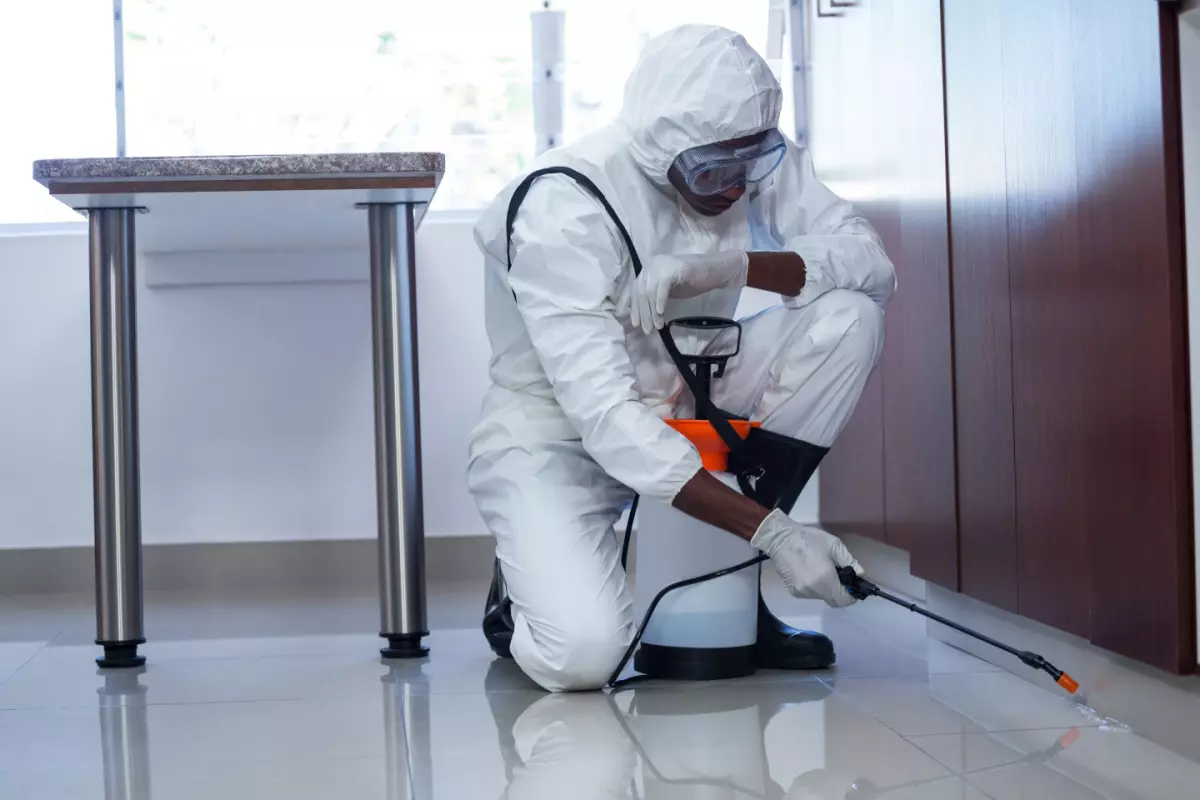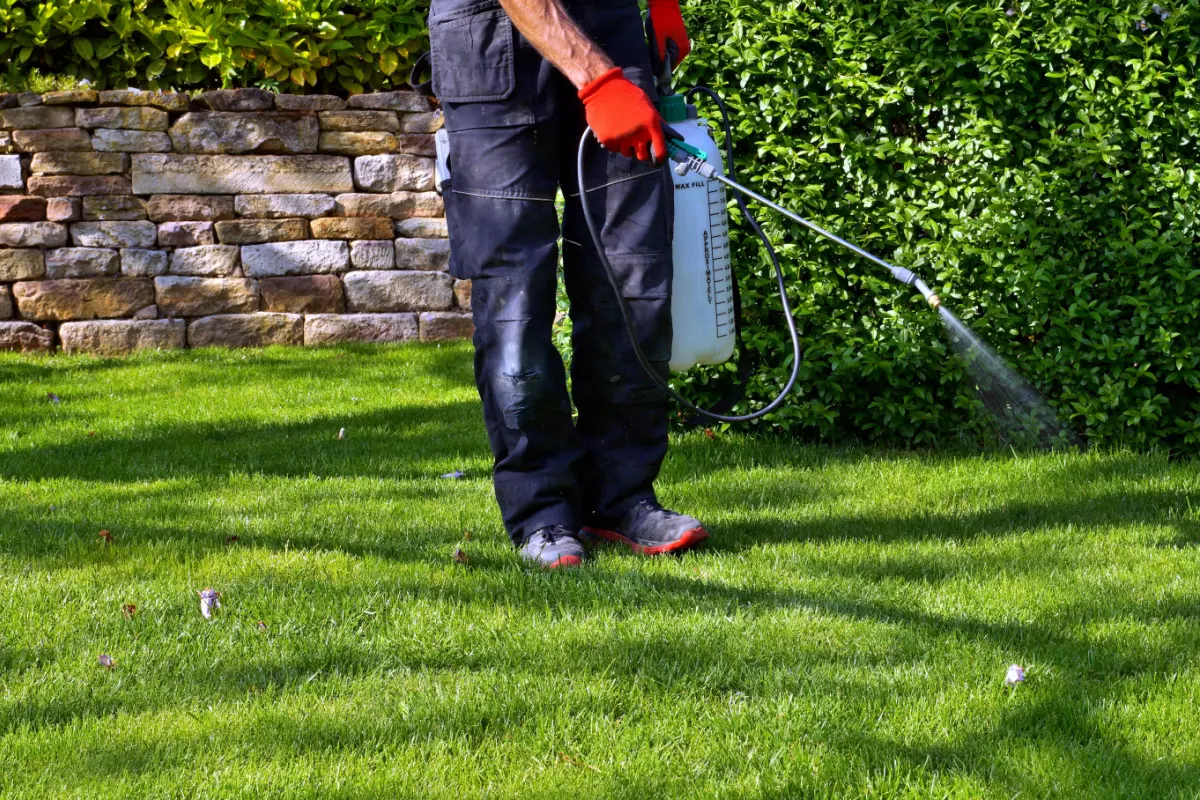Table of Contents
Starting your own pest control business is about turning your hard-earned skills into your own success story. It’s about solving problems that really matter to people, and taking that ability to the next level – your own operation.

This guide aims to equip you with what you need to know to get your business off the ground. Let’s get started.
What Does a Pest Control Service Do?
Pest control businesses work at the forefront of public health and safety by managing, reducing, and eliminating unwanted insects from homes, businesses, and agricultural areas. This includes dealing with common household pests like termites, rodents, and cockroaches, as well as more complex challenges such as wildfire removal and management of agricultural pests that threaten crops.
Starting A Pest Control Business: A Step-by-Step Guide
Starting a pest control business requires careful planning, adherence to regulatory standards, and a commitment to providing quality services. Here is a step-by-step guide on how to successfully start your pest control business:
Market Research and Planning
The foundation of any successful pest control business lies in thorough market research and meticulous planning. Begin by identifying your target market. This could range from residential homeowners to commercial establishments, agricultural sectors, or even government contracts. Assessing the demand within these segments involves understanding their common pest problems, the frequency of these issues, and their readiness to invest in pest control solutions.

Next, analyze your competitors. Look into their services, pricing structures, customer service approaches, and market positioning. For example, if most competitors focus on chemical treatments, there might be a niche for eco-friendly, organic pest control methods that appeal to environmentally conscious customers. Assessing competitors’ online reviews and customer feedback can also uncover opportunities to outperform in areas like customer service or follow-up care.
Armed with insights about your target market and competitors, draft a business plan that details how you plan to enter and capture your market share.
Your pest control business plan should include:
- Executive Summary: An overview of your business, including your mission statement, services offered, and fundamental goals.
- Company Description: Details about your pest control business, including the legal structure, history, and the specific pest control needs you aim to address.
- Market Analysis: Insights into the pest control industry, target market demographics, demand analysis, and a detailed review of your competitors.
- Organization and Management: An outline of your business’s organizational structure, including key team members, their roles, and the management hierarchy.
- Services Offered: A list of pest control services you plan to offer, highlighting the specialties that differentiate your business from competitors.
- Operational Plan: Detailed information on your day-to-day operations, such as customer service protocols, equipment and supply management, and quality assurance
- Marketing and Sales Strategy: Your approach to attracting and retaining customers, including pricing strategies, advertising plans, and sales tactics.
- Financial Plan: A projection of your start-up costs, pricing model, revenue forecasts, profitability analysis, and break-even analysis for when your pest control business will likely become profitable.
- Funding Request: If you’re seeking financing, specify the amount needed and how it will be used.
Legal and Regulatory Requirements
Next, register your business with the appropriate state and federal agencies. This process involves selecting a business structure (LLC, sole proprietorship, partnership, etc.) that suits your needs for liability protection and tax purposes.
An LLC is suitable for small businesses seeking flexibility in management and taxation, offering personal asset protection and pass-through taxation. This means that income is taxed on the personal level rather than at the business level, reducing liability amounts.
Sole proprietorships provide more simplicity and control but lack personal liability protection, while partnerships offer shared control and pass-through taxation but also shared liability.
Once you’ve chosen the business structure, you will need to obtain an Employer Identification Number (EIN) from the IRS. You will need an EIN to hire employees and operate as an LLC or partnership.
What Licenses Do You Need to Start a Pest Control Business?
Pest control businesses require specific licenses to operate, which vary by state and local jurisdictions. Typically, you’ll need a pest control business license, which requires passing an exam that covers pesticide application methods, safety, and environmental protection.
If you’re wondering: “What licenses do I need to start a pest control business?” here’s a state-by-state guide on pest control licensing requirements:
| State | Pest Control Experience | Pest Control Exam Required | Exam Fee | Business License Fee |
|---|---|---|---|---|
| Alabama | Yes | Yes | $75 (offered quarterly) | $125 (offered weekly) |
| Alaska | Yes | Yes | $65 (plus proctor fee) | $25 |
| Arizona | Yes | Yes | $75 | $250 |
| Arkansas | Yes | Yes | N/A ($50 training course) | $10 |
| California | Yes | Yes | $50 (plus $80 application fee) | $160 |
| Colorado | Yes | Yes | $31.50 (plus $100 license fee) | $350 |
| Connecticut | Yes | Yes | $200 (per category) | $0 ($240 if the company has more than one certified pest control applicator) |
| Delaware | Yes | Yes | $30 | $50 |
| Florida | Yes | Yes | $300 (per category) | $300 |
| Georgia | Yes | Yes | $40 | $170 |
| Hawaii | Yes | Yes | $25 (plus $50 initial ID card) | $335 |
| Idaho | No | Yes | $10 | $120 |
| Illinois | Yes | Yes | $75 | $250 |
| Indiana | – | – | – | $45 |
| Iowa | No | Yes | $20 | $25 |
| Kansas | No | Yes | $45 | $140 (per qualification type) |
| Kentucky | No | Yes | $25 | $100 |
| Louisiana | Yes | Yes | $25 – $50 | $200 |
| Maine | No | Yes | $50 | $300 |
| Maryland | Yes | Yes | $10 | $150 |
| Massachusetts | Yes | Yes | $75 | $150 |
| Michigan | Yes | Yes | $0 | $100 |
| Minnesota | Yes | Yes | $0 | $250 |
| Mississippi | Yes | Yes | – | – |
| Missouri | – | – | – | – |
| Montana | No | Yes | $0 | $85 |
| Nebraska | No | Yes | $0 | $90 |
| Nevada | Yes | Yes | $5 | $20 |
| New Hampshire | Yes | Yes | $5 | $20 |
| New Jersey | Yes | Yes | $0 | $150 |
| New Mexico | Yes | Yes | – | $75 |
| New York | Yes | Yes | $100 | $150 to $450 |
| North Carolina | Yes | Yes | $50 | – |
| North Dakota | – | – | – | – |
| Ohio | Yes | Yes | $35 | $35 |
| Oklahoma | Yes | Yes | $95 per category | $100 per category |
| Oregon | Yes | Yes | $58 (per category) | $25 to $90 (per qualification type) |
| Pennsylvania | Yes | Yes | $50 | $80 |
| Rhode Island | No | Yes | $50 – $150 | $45 |
| South Carolina | Yes | Yes | $50 | $50 to $150 |
| South Dakota | Yes | Yes | – | $75 |
| Tennessee | Yes | Yes | $150 | – |
| Texas | Yes | Yes | $100 – $200 | $200 |
| Utah | Yes | Yes | – | $20 to $300 |
| Vermont | Yes | Yes | $0 | $25 |
| Virginia | Yes | Yes | – | $50 to $100 |
| Washington | Yes | Yes | – | $45 to $110 |
| Washington, DC | Yes | Yes | – | – |
| West Virginia | Yes | Yes | $10 | $20 to $60 |
| Wisconsin | Yes | Yes | $0 | $51.40 |
| Wyoming | Yes | Yes | N/A | $25 |
Next, you must adhere to the Environmental Protection Agency’s (EPA) guidelines and state-specific regulations on pesticide use, storage, and disposal. This minimizes the environmental impact of pest control activities. The EPA’s guidelines ensure proper licensing, mandate the use of EPA-approved pesticides, require safe application methods to prevent contamination, and dictate protocols to protect human health and the environment.
Finally, you need insurance coverage to protect your business, employees, and clients. General liability insurance is a minimum requirement, safeguarding against property damage and bodily injury. Additionally, consider policies like workers’ compensation for injured employees, property insurance for equipment and office spaces, and professional liability insurance for negligence claims.
Business Setup and Operations
Next comes choosing your office location, as well as getting the proper equipment and technology. First, opt for a spot that offers both visibility to potential clients and easy access to your primary service areas.

If your target market includes residential homeowners, a location near high-density housing or suburban areas could be ideal. Conversely, if you’re focusing on commercial clients, a location near business districts or industrial parks might be more beneficial.
As a starting pest control business, here are a few pieces of equipment and technology you’ll need to invest in:
- Sprayers and foggers for pesticide application
- Safety gear, including gloves, masks, and protective clothing
- Inspection tools, such as flashlights and moisture meters
- Ladders and drills for access and treatment in hard-to-reach areas
- Vehicles equipped for transporting equipment and chemicals safely
- Customer relationships management (CRM) software for managing customer data and interactions
- Appointment scheduling software like Housecall Pro or ServiceTitan for effective booking and time management
- Mobile payment solutions to streamline billing and payment processes
- GPS tracking for real-time monitoring of service teams and route optimization
- Website and online marketing tools to attract and engage customers digitally
Financial Management
The financial foundation of your pest control business begins with a well-structured budget and a strategic financial plan. Start-up costs can vary but typically include expenses for licensing and insurance, initial inventory of pesticides and equipment, vehicle costs, marketing and branding efforts, and staffing. On average, your pest control start-up costs might range from $12,000 to $23,000.
How Much Does It Cost To Start a Pest Control Business?
Here’s a breakdown of the initial costs you might encounter:
- Business Registration and Licensing: $120 to $2,000, depending on the state and specific licenses required.
- Insurance: Initial premiums can range from $500 to $3,000 annually for basic general liability coverage.
- Equipment Purchases: $5,000 to $50,000 for pest control tools and equipment, such as sprayers, foggers, safety gear, and vehicles.
- Office Space: $2,000 to $5,000 for initial setup if leasing commercial space, depending on location and size.
- Marketing and Advertising: $500 to $5,000 for initial branding, website development, and promotional materials to establish your market presence.
- Training and Certification: $500 to $2,000 per technician for pest control certification, continuing education, and any specialized training required by your state or services offered.
- Inventory: 200 to $2,000 for an initial stock of pesticides, herbicides, and other treatment chemicals.
- Software and Technology: $300 to $1,000 for initial software subscriptions for CRM, scheduling, and accounting software.
Pricing Models and Service Packages
As for your pricing strategy, consider adopting a tiered model. Start with a basic package for general pest control, then also offer a premium package that includes more extensive services, such as termite control. Finally, consider an all-inclusive subscription model for continuous maintenance and prevention.

Most importantly, ensure your pricing covers base costs and incorporates a profit margin. Typically, adding a profit margin of 20% to 30% on top of your base costs is a good starting point, though this can vary depending on the project’s scope and the competitive market.
Each package should clearly outline the services offered, the frequency of visits, and any guarantees or follow-up services included. This approach not only caters to a broader market segment but also encourages upselling and customer loyalty.
Marketing and Branding
Creating a compelling brand for your pest control business goes beyond a memorable logo and catchy name. Your brand should reflect the values and promises you want to communicate to your customers, such as reliability, safety, and expertise in pest management. Here’s how to create your brand:
- Identify Your Unique Selling Proposition (USP): Determine what differentiates you from competitors. Is it eco-friendly pest control methods, exceptional customer service, or specialized treatments for specific pests?
- Design a Memorable Brand Identity: This includes a professional logo, a cohesive color scheme, and a consistent tone that will be used across all marketing channels. Your brand identity should visually and verbally communicate your business’s values and services.
- Craft Your Brand Story: Create a compelling narrative about why you started your pest control business, the problems you solve, and how you make a difference in your customers’ lives. This story will help forge a deeper connection with your audience.
After crafting your brand, develop an effective pest control marketing plan. A solid marketing strategy encompasses a mix of digital and traditional channels tailored to where your customers are most likely to engage with your brand. This multi-channel presence increases your visibility and helps generate leads for your pest control business by capturing interest across different touchpoints. Here are some tips:
- Local SEO Optimization: Given the local nature of pest control services, you should optimize your online presence for local search engine results. Ensure your business is listed on Google My Business, and focus on collecting positive reviews from satisfied customers. Utilize local keywords in your website’s content to improve your visibility in search results for pest control services in your area.
- Educational Content Creation: Position your business as an industry expert by sharing educational content through blog posts on preventing common pests, videos demonstrating safe pest removal techniques, or infographics on seasonal pest trends.
- Targeted Social Media Campaigns: Use social media platforms to target your local community with ads and organic posts. For instance, Instagram ads cost between $2.50 and $3.50 per thousand impressions. Showcase your services, share customer testimonials, and engage with local events and news to foster community engagement.
- Referral Programs: Encourage word-of-mouth marketing by implementing a referral program. Offer incentives like discounts to current customers for referring new clients.
- Direct Mail Campaigns: Send out flyers, postcards, or seasonal promotions to households in your target area.
Staffing and Training
In the competitive pest control industry, the quality of your service hinges on the skills and professionalism of your staff. Focus on hiring candidates with a solid entomology background or who have completed certified pest management training programs. For instance, the QualityPro Certification by the National Pest Management Association (NPMA) indicates a foundational knowledge of pest biology and control techniques, which is key for delivering effective services.

Also, prioritize candidates with strong communication skills, empathy, and a customer-oriented mindset. These soft skills help build client trust and satisfaction. For instance, after treating a home for pests, a skilled technician can educate the homeowner on preventative measures, turning a routine service call into an opportunity for customer engagement.
Additionally, foster a culture of ongoing education amongst employees so they keep up with the latest developments in pest control technologies, safety protocols, and environmental regulations.
Customer Acquisition
The next step involves growing your pest control business by acquiring customers who will remain loyal to you. Building partnerships with local businesses like real estate agencies, home inspection services, and local hardware stores can create a referral network that benefits all parties involved. Such alliances broaden your exposure and position your business as a trusted community resource.
Above all, ensuring customer satisfaction is the backbone of sustained business growth. Delivering exceptional service, from the initial contact through the completion of the job and beyond, sets the foundation for a loyal customer base.
Follow up with clients to gather feedback, address any concerns promptly, and continuously look for ways to enhance the scope of your services. By prioritizing customer satisfaction, you retain clients and create ambassadors for your brand, driving organic growth through positive reviews and recommendations.
Technology Integration
Lastly, integrating technology can streamline operations, enhance customer service, and help you stay competitive. Embracing business management software like Housecall Pro or Jobber helps manage customer data, financial transactions, and day-to-day administrative tasks efficiently. By centralizing business operations to one software solution, you can reduce manual errors, save time, and improve overall productivity.

To further enhance operational efficiency, appointment scheduling, and routing tools help optimize your technicians’ schedules and routes, ensuring that appointments are booked logically, minimizing travel time, and maximizing the number of clients served each day. Not only does this increase efficiency, but it also improves customer satisfaction by ensuring timely service.
Finally, consider implementing pest and termite control financing into your service offerings to make pest control services more affordable to a broader range of customers. By providing flexible payment options, your customers can access immediate treatment without financial strain.
For your pest control business, it means potentially higher average ticket sizes, increased conversion rates, and cultivating long-term customer relationships. Providing alternative financing options can also set your business apart from competitors, offering a value-added service that addresses the direct needs of the customer while ensuring the business remains financially robust and capable of expanding its market reach.
Summary
Starting a pest control company is all about combining top-notch service with smart technologies. Success here goes beyond just getting rid of pests, but about building a brand that stands for trust and unparalleled customer care.


